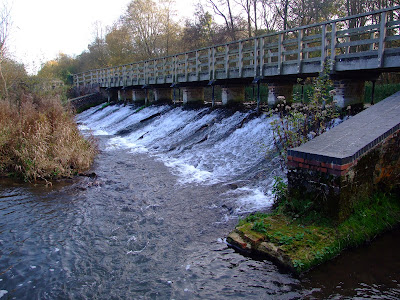Although the Kennet and Avon Canal is not normally the focus of this blog, it has a significant bearing on the Kennet Navigation and the riverine levels where it is a primary feeder source from just above Hamstead Lock. With the closure of a long section of the K&A Canal last Thursday, it would seem likely that the lower reach of the River is now facing an indefinate extension or even exacerbation of the low water levels currently evidenced.
The British Waterways announcement stated:
"Stoppage: NAVIGATION CLOSED UNTIL FURTHER NOTICE LOCK 61 TO LOCK 80
17 Nov 2011 until further notice
The canal has been closed to navigation between Crofton Lock 61 and Copse Lock 80 due to lack of adequate water supplies to support boat movement.
All of the locks within the closed section will be padlocked to prevent use. We are allowing levels in individual canal pounds to recover slowly. Several sections are very low and will take some time to come back to normal level. This is a long term problem brought about by ground water level being extremely low, in fact it is at the lowest level for 90 years.
The reservoir level is also very low and currently has little or no feed to recharge the system. The current stoppage is necessary to recover levels and help protect aquatic life in the canal.
British Waterways is currently looking to support the closed section with additional water supply from other sources.
The current closure is being reviewed weekly, and with little or no significant rain forecast the current closure may remain in force for some weeks."
The CEH October hydrological summary had already identified the critical lack or rainfall, exceptionally low river flow and almost record breaking low level of groundwater reserves on the 11th Novenber, so with the River Kennet failing in its own right, the news from the canal was most unwelcome.
The view at Benham Weir from the bottom of the fish pass on Sunday 13 November 2011.
The footings of the weir buttresses would be covered for sufficient paddling levels, so whilst it would be possible to descend from the second space from the left as you approach the top of the weir...
...downstream paddling would probably be a scrape with the possibility of hitting spawning trout redds in current conditions.
The British Waterways announcement stated:
"Stoppage: NAVIGATION CLOSED UNTIL FURTHER NOTICE LOCK 61 TO LOCK 80
17 Nov 2011 until further notice
The canal has been closed to navigation between Crofton Lock 61 and Copse Lock 80 due to lack of adequate water supplies to support boat movement.
All of the locks within the closed section will be padlocked to prevent use. We are allowing levels in individual canal pounds to recover slowly. Several sections are very low and will take some time to come back to normal level. This is a long term problem brought about by ground water level being extremely low, in fact it is at the lowest level for 90 years.
The reservoir level is also very low and currently has little or no feed to recharge the system. The current stoppage is necessary to recover levels and help protect aquatic life in the canal.
British Waterways is currently looking to support the closed section with additional water supply from other sources.
The current closure is being reviewed weekly, and with little or no significant rain forecast the current closure may remain in force for some weeks."
The CEH October hydrological summary had already identified the critical lack or rainfall, exceptionally low river flow and almost record breaking low level of groundwater reserves on the 11th Novenber, so with the River Kennet failing in its own right, the news from the canal was most unwelcome.
The view at Benham Weir from the bottom of the fish pass on Sunday 13 November 2011.
The footings of the weir buttresses would be covered for sufficient paddling levels, so whilst it would be possible to descend from the second space from the left as you approach the top of the weir...
...downstream paddling would probably be a scrape with the possibility of hitting spawning trout redds in current conditions.










































